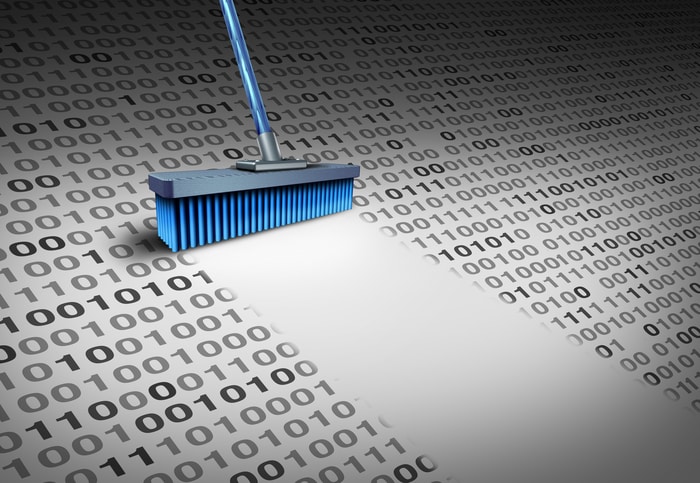Data list management and data hygiene don’t rank highly on the list of most exciting marketing topics, but smart marketers know what valuable assets they are. In fact, they’re vital to any type of direct mail marketing campaign. So before you send that next batch of letters, postcards, catalogs, or packages, get your data in order so you can get the most out of your marketing efforts.
Here’s your essential guide to data list management and data hygiene.
What is Data Hygiene?
Data Hygiene Definition
You’ve heard the marketing term data hygiene or data cleansing. It’s defined as the processes involved with making sure data is “clean” or free of errors. The opposite of clean data is dirty data. This is when you have duplicate records (aka dupes), incomplete or outdated data, or bad parsing of fields from different systems.
Why is this bad? Let’s look at duplicates. Dupes cause marketing departments to overproject. Imagine if 10% of your 50,000 leads are duplicate contacts. If you’re projecting that 20% of those 50,000 will buy your product or service, you’re not basing it on the duplicates you weren’t originally aware of. Hence, overprojection. There are other problems. Think of it from the consumer side. What if you receive multiple pieces of the same direct mail? That’s annoying (and confusing) to your prospects plus you’re spending twice as much to send them mail. Bottom line: bad data affects your brand’s ROI.
So whether you call it data hygiene or data cleansing, you need to get your data in order. It’s a crucial part of your brand’s direct mail marketing success. Are you ready to send your next direct mail marketing campaign? Here are a few steps you should take.
1. Analyze Your Data

Audit all the platforms where you collect information. Mailing list forms. Survey forms. Landing page download forms. Keep in mind, if you ask for too much information too early in your relationship with your potential customers, you’re increasing your chances for “dirty data.” People are more inclined to provide false information if there are too many input fields to complete.
Let’s say your brand has a slew of bad data that you’re just becoming aware of. Maybe you’ve had a variety of circumstances that led to this or it was a case of simply not knowing how you should handle your data. Perhaps you weren’t aware of the correct procedures for collecting it. Whatever the reason, your data’s a mess. It’s full of dupes and outdated and/or incomplete information, etc. Maybe each department within your organization has different data and its own process for obtaining it. Needless to say, that leads to an abundance of errors. As a result, bad data costs the U.S. $3 trillion per year. Don’t be part of that startling statistic.
Here’s How to Analyze Whether You Have Bad Data
The key is to analyze your situation and discover whether or not you have a problem. From there, you can set the best course of action into motion—which is getting rid of your dirty data and replacing it with the correct information. Here are a few tips to help with analyzing bad data.
- Check to see how data is entered into your CRM software. Then establish data entry rules, like searching for a name before entering a new contact into the system. Think of it as a style guide and be consistent.
- Place your leads into manageable categories, like long-term buyer, disqualified buyer, etc.
- Setup automatic deduplication. Your CRM likely has a feature that will auto-check for nearly identical records.
This is a process you should complete on a regular basis. In fact, setting up a maintenance schedule is a great way to combat dirty data.
2. Clean Your Dirty Data Often

Granted, it’s difficult to achieve a 100% accurate list (mistakes are inevitable and names and addresses can change frequently), but you want to limit these as much as possible. After all, a simple spelling error can result in losing a valuable lead. In turn, that could cost your company an enormous amount of lost revenue.
The best practice is to clean your data on a regular basis rather than “once in a while.” Keep in mind that if you rent a list (read more about this below), you should merge, purge, and check for dupes. The National Change of Address database includes everyone (individuals and businesses) who filled out a change of address form in the past four years. Use it to your advantage. Send your database to the NCOA, and you’ll have your list’s latest mailing addresses.
Need some help with that? We’ll use the NCOA and other data list management and data hygiene methods for assuring your info is clean and ready for your next direct mail marketing campaign. Contact MSP to get started.
Renting a Mailing List? Here’s Some Data List Management Advice
If you’re renting a mailing list, be sure to select a well-founded list owner. Whatever type of list you acquire (response or compiled), be sure to ask the broker or provider these two questions, at the very least:
- Where did you get your data?
- When was it last updated?
Also, be sure you receive data hygiene and optimization as part of your agreement. This will give you a clean list.
Naturally, you also want to ask the same questions you’d ask any business you’re considering working with. How long have you been in business? Check their reputation and reviews. How much do they charge? If possible, look for a provider that has experience working with clients who target the same consumers you’re targeting. And find out what their lists look like and what info they include. Once you have the answers to these questions, you’ll have more confidence to work with them—or to look for another provider.
Merging and Purging Data for Better Data List Management
The foundation of dirty data is duplicate addresses. Many organizations use an email address as the primary field for determining the difference between contacts. This leads to dupes. For example, if a customer enters their personal email address on one form, then their work email on another, you’ll have two separate records for that person. This diminishes your ability to get a proper view of your customers. Data cleansing systems typically use multiple rules for eliminating dupes. This is important for proper data hygiene and list management.
3. Find a Data Ambassador

Any organization with more than one department is susceptible to multiple databases. This usually results in more than one person entering data. Additionally, they may use different tools to enter that information. So the accounting department could be doing one thing while billing is doing another. Two departments, two people (or more) entering data.
All this information should funnel through one resource that recognizes and sees to it that the data is clean. Having one data ambassador in charge is the optimal way to make sure this happens for your entire organization.
4. Raise Your Standards for Data List Management
Do you have a forward-thinking plan in place for data hygiene and list management? What standards will you follow as you head into the future? When you develop a written plan and follow it, you’ll have accurate lists and your direct mail campaigns will have a faster time to market and a higher return on investment. Follow the aforementioned recommendations and you’ll be well on your way to mastering data hygiene and list management.
How’s Your Data Hygiene and List Management?
Do you have clean data? Before you send out another direct mail marketing campaign, clean up your information for the best return on your investment. MSP provides NCOA services, checks for dupes, and much more. For example, we can perform a data suppression that removes, adds, or amends the information within your database to be sure your data is correct and up-to-date. This will maximize your response rates and ROI.
For a detailed analysis of your data—and to address all your direct mail management needs—contact an MSP representative today.
How Effective is Direct Mail Marketing?
As a smart marketing professional, you know that direct mail is a wise choice to include in your multichannel arsenal. But exactly how effective is direct mail marketing? We're here to answer that question for you. Direct Mail Marketing Continues to Grow ...
How to Optimize Your Direct Mail Postcards
Marketers from every industry love direct mail postcards because they're affordable and effective ways to advertise their products and services. So we applied our 65+ years of knowledge and came up with a few tricks you can use to boost your results. Here's how to...
Direct Mail Advertising Costs: Here’s What to Look For
Marketers want to know how to get the best return for their advertising dollars. So we assembled the typical direct mail costs to show you what's involved and what options you'll have when it's time to plan your next direct mail campaign. Direct Mail...





